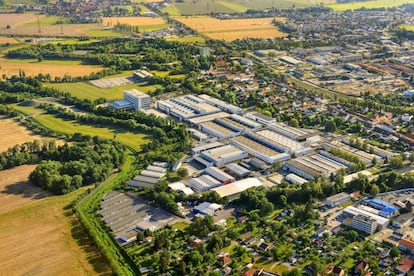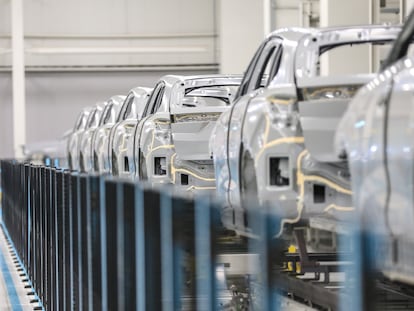Bosch tests fuel cells in the Czech Republic
The largest manufacturer of automotive components sees hydrogen as the future for heavy-duty mobility


Bosch’s plant at České Budějovice, one of the German company’s largest research and development centers in Europe, perfectly encapsulates the changing times in the auto industry. Built three decades ago, the plant took advantage of the lower labor costs of what, at that time, was Czechoslovakia. For years, the factory has been a powerful center for the production of components for automobile companies: thousands upon thousands of brake pedals and exhaust pipes of vehicles manufactured by German automotive giants left the factory year after year. Today, with the car sector undergoing unprecedented change and with the shelving of diesel and gasoline just around the corner, the Czech plant is fighting for its own reconversion, and that of the whole group, which is the world’s largest manufacturer of automobile components.
Despite repeated attempts to extend the deadlines by the major European brands — much further behind in electrification than their Chinese competitors and, above all, than the American Tesla — there is a clear reality: the last combustion car will be registered in Europe in 2035. Or even sooner, if you look at the total paradigm shift in Norway and China, or even in the Netherlands (inside the EU): the future of cars lies in batteries — which require far fewer components than their internal combustion predecessors — while the future of trucks and buses probably relies on a mix of electric and hydrogen fuel cells, which allow a greater travel range and reduce charging times although at the cost of lower efficiency.
“We are aware that cars will be mostly electric, but we believe that the fuel cell, powered by green hydrogen, can have a significant presence in long distance, high-tonnage vehicles, such as trucks,” explains Alan Celić, head of the plant located in southern Bohemia, which EL PAÍS was invited to visit this week. He goes a step further: “The hydrogen cell is the best alternative for this type of vehicle to make the leap from diesel, because it avoids the weight of the batteries and reduces recharging time: truck drivers can’t wait for a battery to be charged to 100%. It’s not efficient.”
These days, Bosch’s own global website is a declaration of intent: accessing its corporate portal, readers find a premonitory motto in five columns: “Hydrogen: energy for the future.” The same thing happens in České Budějovice: catalytic converters and tail pipes have now made way for a chemical symbol: H₂O. All their efforts are now focused on the green molecule, called upon to play a key role in the energy transition: from purification systems for poor quality water and even seawater (so that they can be used in the process of generating green hydrogen) to electrolyzers or fuel cells. Although energy is the company’s third branch of activity, after mobility and consumer goods, it is the sector that is growing the most.
Bosch’s choice of the Czech Republic is by no means arbitrary. Its presence here, a country of just over 10 million inhabitants and located at a privileged crossroads in Central Europe, dates back to the 1920s. Interrupted for a few years by the World War II, the great acceleration occurred in the eighties and nineties, when low salaries and the quality of its human capital made it a priority destination for German manufacturing investment, especially for the automotive industry. Those were the years — the decades, rather — in which multinationals had cost-cutting as their only guide. And the years, too, in which both Slovakia and the Czech Republic became what they are today: the two largest car manufacturers in Europe and two of the three largest in the world.
Wage gap
There you can also see that times have changed. The Czech Republic maintains its privileged position in the world table of producers — largely due to Škoda, now a subsidiary of Volkswagen — but the wage gap with respect to the most prosperous countries in Europe has narrowed. “Workers are more expensive and the Czech labor market is practically empty,” says Milan Šlachta, head of Bosch in the Czech Republic and Slovakia, referring to the very low unemployment rate (just over 2%, the lowest in the EU) and the fight for the best profiles that is intensifying between companies. Both factors, together with automation and the much lower need for components for electric cars, will reduce the productive size of this plant. However, other, more technical profiles produced at the plant have continued to gain importance.
Cheap labor is no longer what is sought in České Budějovice, halfway between Vienna and Prague and closer to the border with Austria than to the Czech capital itself. Among the employees of this hybrid plant — in which manufacturing and R&D coexist — white collars these days outnumber blue collars. By a landslide: seven out of ten employees have higher education degrees. In that group, the dominance of engineers is overwhelming. There is a legion of 800 people, of which one in three works on projects linked to green energy. Soon, diesel and gasoline will be left behind: the future is reserved for electricity and the hydrogen fuel cell.
An atypical company
Bosch is not a typical company. With more than 420,000 employees worldwide, almost 86,000 of them dedicated to research and development, it is the only German liner that is not only not listed on the stock market, but has a very large majority of its capital (92%) in the hands of a non-profit foundation (the Robert Bosch Stiftung GmbH) at the express wish of its founder, who gives its name to both. Last year, Bosch won more than 1,800 million, compared to the 2,500 of the previous one, and distributed 162 and 143 million in dividends in 2022 and 2021, respectively. Of that money, a large part went to health and education projects.
If a firm embodies the values — and the clichés — of the German industry, it is this one: no concessions, fuss or redundant costs. Also in České Budějovice, in southern Bohemia, where an additional point of secrecy is added to this cocktail: the few visitors who pass through its facilities each year do so with the cameras of their mobile phones covered with a striking red sticker to prevent them from photographing the prototypes their engineers are working on. The reason for such security lies in R&D (to which it dedicates more than 7,000 million a year) and in patents: the company registers almost a dozen of them every day in everyone.
Sign up for our weekly newsletter to get more English-language news coverage from EL PAÍS USA Edition
Tu suscripción se está usando en otro dispositivo
¿Quieres añadir otro usuario a tu suscripción?
Si continúas leyendo en este dispositivo, no se podrá leer en el otro.
FlechaTu suscripción se está usando en otro dispositivo y solo puedes acceder a EL PAÍS desde un dispositivo a la vez.
Si quieres compartir tu cuenta, cambia tu suscripción a la modalidad Premium, así podrás añadir otro usuario. Cada uno accederá con su propia cuenta de email, lo que os permitirá personalizar vuestra experiencia en EL PAÍS.
¿Tienes una suscripción de empresa? Accede aquí para contratar más cuentas.
En el caso de no saber quién está usando tu cuenta, te recomendamos cambiar tu contraseña aquí.
Si decides continuar compartiendo tu cuenta, este mensaje se mostrará en tu dispositivo y en el de la otra persona que está usando tu cuenta de forma indefinida, afectando a tu experiencia de lectura. Puedes consultar aquí los términos y condiciones de la suscripción digital.
More information
Archived In
Últimas noticias
Most viewed
- Reinhard Genzel, Nobel laureate in physics: ‘One-minute videos will never give you the truth’
- Oona Chaplin: ‘I told James Cameron that I was living in a treehouse and starting a permaculture project with a friend’
- Pablo Escobar’s hippos: A serious environmental problem, 40 years on
- Chevy Chase, the beloved comedian who was a monster off camera: ‘Not everyone hated him, just the people who’ve worked with him’
- Why we lost the habit of sleeping in two segments and how that changed our sense of time










































